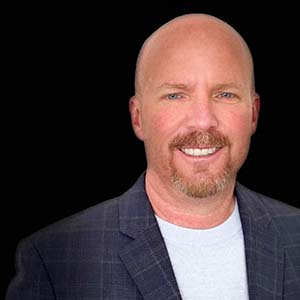Rethinking Healthcare’s Next Evolution
Fresnel Growth Capital is thrilled to welcome both Sean Field and XMed to the Fresnel family. Sean is the CEO of Xmed, and from day one has delivered the necessary critical thinking and innovation needed with a vast healthcare background. Entrepreneurship runs in his veins, with several companies created and then sold under his leadership. Sean pioneered technologies that reinvented how medical information is gathered, and he’s still doing it, and he shares his fresh perspective on the future of healthcare data, Xmed, and his work with The Fresnel Companies.

The Lens: Tell us a little about your background.
Sean Field: I got my start in 1990 when I founded a data-management company focused on critical-care diagnostics in hospitals. I saw an opportunity. I was young—20 years old—and my father worked in the critical-care testing field. I saw the lack of connectivity for the diagnostics results and the need for data management that was not taking place in that world.
I founded a software company together with a friend of mine who was a software engineer. Our company, called Laboratory Data Systems, was the first connectivity and data-management solution for decentralized testing in the hospitals. It was kind of a big deal, because back then it really was primarily critical care blood gas testing that was being done near the patient, or now what we refer to as the point-of-care. Whereas everything else was sent to the central laboratory for analysis.
We pioneered the connectivity, from both a hardware and communication protocol perspective. Therefore, not only were results captured for those tests analyzed in the near-patient-testing setting, but it created the foundation for other devices or tests to establish connectivity capability throughout the hospital. This enabled expansion of more routine tests to near-patient testing with connectivity being the conduit to improved patient-care outcomes. We provided quick results for more routine tests. For example, 30 years ago, for what we perceive today as a simple Glucose test, your blood was drawn and was sent to the lab for analysis. With the advent of connectivity solutions, and technological advancements of diagnostic devices, our solution served as a catalyst that enabled testing to leave the central laboratory and be done at the point-of-care.
TL: Sounds like a pretty fundamental change in the way healthcare is delivered. What happened next?
SF: I sold that company about eight years after I founded it, and went to work for the company that bought it, which was a major diagnostic equipment manufacturer for hospitals. Then about a year and half later, we sold that company to Roche Diagnostics, the largest diagnostic testing company in the world.
I moved overseas to work at Roche for five years, and founded a division of the company that was primarily focused on the information technology and actionable health information. That was really kind of the first step in the industry towards taking data and aggregating it in such a way to help improve patient outcomes through better medicine techniques based on data as opposed to just based on experience.
TL: It sounds like you were still pursuing the same idea: better healthcare through better information.

SF: That’s correct, but I saw much more opportunity than what we were pursuing. So I left that job and came back to the United States, and refounded my old company, Laboratory Data Systems, and went back and did the whole thing all over again. This time, we had a much bigger focus on all point-of-care testing, since the world, point-of-care testing and information had changed so much, so quickly. Eight years later, I ended up selling it to the largest point-of-care diagnostic company in the world, Alere. I worked for them for a few of years, running their informatics division.
When my contract was up with them, I decided to leave. I thought I was going to semi-retire, you know, go fishing and play golf, and all that kind of stuff. I realized very quickly that I just needed to be busy and involved in something that I believe in, where I feel like I could be beneficial and help something grow and make it into a great company. It didn’t necessarily have to be a healthcare informatics company.
I started looking around and got involved in some ventures and some startup businesses, not so much involved in the day to day, but it did lead me to people like Fresnel partner Andrew Murphy. We have become very good friends in a relatively short time. And whenever there have been opportunities for us to collaborate and work together on things, we’ve done that.
TL: And the next opportunity came out of that ongoing conversation?
SF: That’s how I got involved with Xmed. Andrew knew my background in medical software, and felt like I’d be really good for the organization from a leadership perspective.
I really like the concept behind the platform. It’s a social and community-oriented environment, that we’re looking to create from a health and fitness perspective, as opposed to just being a website with informational content. We’re already working with the team on a lot of strategic stuff, setting up development teams and other things. But we are very focused on what we believe is going to be a unique way to present, engage, and share health and wellness information.
TL: Does Xmed present another paradigm shift?
SF: With an app, one of the things that I think we all see on the surface is what it does, and our understanding usually stops there. Look at an example, like Teladoc. It’s a telemedicine platform, where people go online and visit with a doctor, get a diagnosis, and get a prescription. The invention of it was created at Roche Diagnostics, back in 2004, and I was actually part of an innovation team at Roche that created the initial platform. We didn’t call it Teladoc back then, but it’s gone through multiple hands of ownership, multiple transformations to its look and feel, and whatever else. But what people see today on the surface, is the feature of a virtual doctors visit or consultation.
What they don’t understand is that there is a now a whole new subset of data that the medical world is starting to collect on illnesses, symptoms, or problems that patients are having that can be handled and managed without a doctor’s visit. It really does come down to the data, rather than just finding another way to provide treatment. Because at some point in time, we’re going to learn from the data that there are certain things you just can’t do with telemedicine. And there are a lot of things we didn’t think we could do. But now we realize we can, and I find it incredibly interesting to be able to analyze and understand the information in that data and then just see where the telemedicine part of this is going to be 10 years from now. The data is going to drive that.
TL: That sounds very promising for changing the way healthcare is delivered.
SF: I think 10 years from now we may find ourselves very rarely going to the doctor. With the Internet-of-Things, which is what diagnostics devices fall into now, we have the connectivity, the test results, treatment information, and thus the data for the analytics, that will drive change in how healthcare can be administered.
I think this is where general practitioner care is headed. Solutions like Teladoc, and a key part of what we are building on Xmed, will serve as a platform for getting physician care when you feel you need it for a fairly routine illness or symptoms. The platform has its own pool of physicians and patients can schedule a visit with a licensed physician or possibly get an immediate consult if a physician is “online” and accepting “walk-ins.”
TL: You’re talking about a shift in how people gain access to healthcare. Xmed seems to be looking at the next generation of patients.
SF: What I feel is going to make Xmed different, from a health and wellness app perspective, is that it’s based on the concept of a community, that’s socially interactive, sharing and engaging in many aspects of our daily health and wellness needs.
It’s more than an application where you go to find your physician or get a diagnosis and a treatment. It’s also where you can go to find out whatever you need or want to know. If you’re into fitness, it can be your fitness platform. We’re engaging with experts, motivators and influencers, who will be members on our app, who provide fitness activities or training classes or whatever it may be.
If you think about the industry today, all these things are separate. If you wanted workout videos, you get a fitness app where you get workout videos. And you figure out what you want to do: Am I doing flexibility? Am I working on strength training? Do I want a cardio session?
I’ve tried one of these, and the app assigned a coach to me. I didn’t choose the coach. And when I had questions about what I can do, if I find my performance has plateaued, that’s the only avenue of information that was provided. I see this as a problem and the solution is the social community focused on many aspects of health and wellness including general care, physical health, nutrition, mental health, the list goes on.
TL: That other app sounded reminiscent of the old ways of healthcare, when you were assigned a doctor.
SF: Exactly, and that’s what Xmed does differently, we want to allow the community to be part of that conversation. Yes, you can see your doctor, or another doctor or expert on the platform. But that doesn’t have to be your only avenue to finding the information or solutions you need. Why not provide a platform that enables a member to engage the entire community? Let the community have a voice, and share their experiences: Hey, this works for me, or This didn’t work for me, this might work for you. Whatever it may be.
The demographic we’re targeting—people who are younger now, have a comfort level with technology and social media, and are going to be needing increased healthcare as they get older—they tell us that they’re looking for that engaged community. It makes them want to keep coming back to the platform to get the information that they’re looking for, and have that interaction with other people who may be experiencing the same things or have other insights.
Part of our strategy is ensuring recurring use of the Xmed platform. If we were just providing a Teleconsult app, we don’t drive recurring use. We will provide features, tools, and information that will make it an everyday app for our users. We will employ gamification concepts that make it rewarding in many ways. These tools and rewards systems will encourage greater engagement in the app and drive the creation of new data that will hopefully enable the new advancements in healthcare.
At the end of the day, Xmed can make healthcare far more effective than it is today, even if it doesn’t necessarily deliver any major medical advances, such as a cure for cancer. We can definitely enable dramatically improved health and wellness to the lives of many people and because of that I’m very excited to be a part of it.
